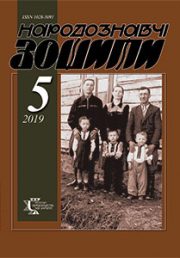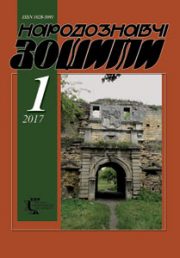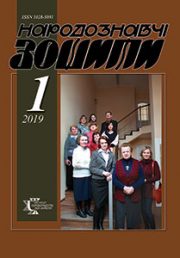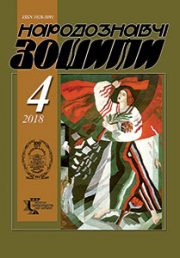The Ethnology Notebooks. 2022. № 3 (165), 573—579
UDK 73/76:7.041.5:698. 1 (477.87) “1900/1950”
DOI https://doi.org/10.15407/nz2022.03.573
IVANYTSKA Tetiana
- ORCID ID: https://orcid.org/0000-0003-4932-0956
- Postgraduate student, Lviv National Academy of Arts,
- 38, Kubiiovycha Str., 79011, Lviv, Ukraine,
- Teacher of the College of Arts
- A. Erdeli of the Transcarpathian Academy of Arts,
- Transcarpathian region, Ukraine,
- 38/80, Minayska Str., 88015, Uzhhorod, Ukraine,
- Contacts: e-mail: tetyana02@gmail.com
Abstract. The history of formation and becoming of portrait painting of Transcarpathia is considered in the article. The art of the first representatives of secular painting of the late XIX — early XX centuries is studied — J. Miklovsky’s Snake, F. Heverdle, Y. Vyraga. The portrait works of the founders of the Transcarpathian art school — A. Erdely and J. Bokshay are analyzed. It is proved that the formation and development of portraiture of artists was significantly influenced by such factors as: the natural environment of the Transcarpathian region; professional education of painters obtained in art schools in Europe; socio-political conditions in which Transcarpathia was in the first half of the twentieth century.
It is confirmed that the main artistic styles and directions that characterized the European art of the late XIX — first half of the XX century are represented in the portrait works of regional artists: academicism, impressionism and post-impressionism, neo-romanticism, and the avant-garde expressionism. Emphasis is placed on the special characteristics of the Transcarpathian painting tradition, which includes the aesthetic understanding of ethnoculture and the complementary role of artistic codes of folklore and folk poetics. The relevanceof this article is to identify ways to form and develop the features of portrait painting of the first half of the twentieth century, and the need to understand the characteristic typological features in the gradual evolution of the image of the Transcarpathian man. The purpose of the study is to identify and characterize the main typological and artistic and stylistic features of the portrait image based on the paintings of Transcarpathian artists of the first half of the twentieth century.
The object of research is the portrait works of Transcarpathian painters of the first half of the twentieth century, and the subject — typological and stylistic features of the interpretation of the image of the mountaineers, the nature of the visual language.
As a result of the research it is proved that the portrait works of Transcarpathian artists of the first half of the XX century demonstrates a wide range of artistic and stylistic manifestations that have evolved from academic writing to variable means of impressionistic or expressionist color painting. The detailed typology of pictorial images is clearly defined — from representative to communist-ideological, the peculiarities of their artistic interpretation are clarified.
Keywords: Transcarpathian painting, portrait painting, typology, image, stylistics, ethnic type, social realism.
Received 26.05.2022
REFERENCES
- Ostrovskyi, G. (1974). Fine art of Transcarpathia. Kyiv: Art [in Ukrainian].
- Lutsenko, I.V. (2014). Painting of Transcarpathia at the end of the XIX — first half of the XX century: genres and artistic and stylistic features (PhD). Lviv [in Ukrainian]
- Lutsenko, I. (2013). Traditions of ethno-romanticism in the painting of Transcarpathia in the first half of the twentieth century. Scientific Bulletin of the ZHI, 4, 277—285 [in Ukrainian].
- Yukhimets, G.M. (1983). Ukrainian Soviet art of 1941—1960. Kyiv: Art (Essays on the history of Ukrainian art) [in Ukrainian].
- Virag, Julius. (1999). Figures of history and culture of Transcarpathia: Small encyclopedic dictionary (Pp. 36—37). Uzhhorod [in Ukrainian].
- Pop, I. (1992).Transcarpathian school of painting as a phenomenon of national and cultural revival. Carpatica — Carpathians: Current issues of history and culture of Transcarpathia (Issue 1, pp. 181—196). Uzhhorod [in Ukrainian].
- Voron, B. (2011). Transcarpathian school of painting: great art from the «small land». Art Almanac Artes. Retrieved from: https://artes-almanac.com/zakarpatska-shkola-zhyvopysu [in Ukrainian].
- Kushnir, Mikhail. (2004). Our ethnic positions. Art, 1, 40—44 [in Ukrainian].
- Dyerke, H. (2017). Formation of conceptual foundations of regional neo-folklore in Transcarpathian painting of the 1920s — early 1940s. The Ethnology notebooks, 4 (136), 920—927 [in Ukrainian].
- Erfan, F., Prikhodko, O. (Eds.). (2016). Joseph Bokshay (Illustrative material): album. Uzhhorod: Carpathians [in Ukrainian].







